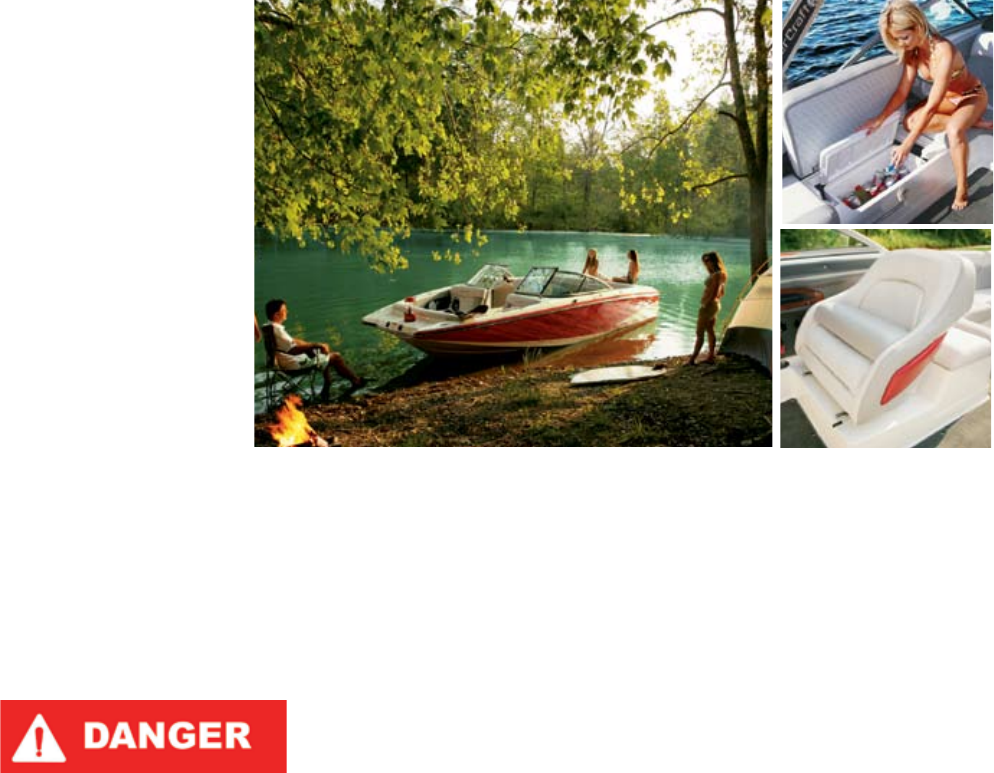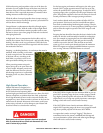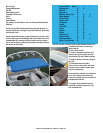
With both steering and propulsion at the rear of the boat, the
initiation of a turn pushes the stern of the boat away from the
direction of the turn. e stern follows a larger turning circle
than the bow. is is especially important to remember when
making maneuvers within close quarters.
While the eects of unequal propeller thrust (torque steering),
wind, and current may not always be present, a practiced driver
will use them to his/her advantage.
Unequal thrust is a phenomenon shared by all single-engine,
propeller-driven boats. With the rudder in the straight-ahead
position, a counterclockwise rotation propeller tends to cause
the boat to drive to port when going forward, and to starboard
when going backward.
At high speed, there is compensation for this eect, and it is
virtually non-existent. But, at slow speed—and especially during
backing—the eect can be very pronounced. is is the main
reason that most experienced drivers approach with the dock to
the starboard of the boat.
Stopping—or checking headway—is a technique that must be
mastered. With no brakes, reverse must
be used to stop the boat. e momentum
of the boat will vary according to the
load. Make it a practice to slow to no-
wake speed before shiing into reverse.
When practicing maneuvering tech-
niques, always do so in open water that
is free of trac. Adequate practice may
make the dierence between a pleasur-
able boating experience or a potentially
damaging (at the very least, embarrass-
ing) one.
High Speed Operation
MasterCra boats are designed to be
a high-performance boat. Professional
drivers with advanced operating skills
perform high-speed maneuvers and turns on-a-dime. DO NOT
attempt to duplicate or simulate these feats. Paid, professional
drivers log thousands of hours on the water and carefully cho-
reograph every move. Plans are made in advance in the event the
routine must be aborted. Maneuvers of this nature could cause
serious injury or death, as well as damage to your MasterCra
boat that will not be covered under warranty.
Boat operators should never attempt to duplicate operational
skills of professional drivers. When such maneuvers fail, it can
result in serious injury or death.
For the best engine performance and longevity, the wide-open-
throttle (WOT) engine operation must be near the top of, but
within, the specied WOT operating range. To adjust the WOT
operating range, select a propeller with the proper diameter and
pitch. e propeller supplied on the boat was chosen for best all-
around performance under average operating conditions.
Load, weather, altitude and boat condition all aect WOT en-
gine operation. If the boat is used for several dierent applica-
tions such as wakeboarding, barefooting and cruising, it may be
necessary to have two (2) or more propellers of diering size and
pitch to allow the engine to operate in the WOT range for each
application.
Propping the boat should be done aer the boat is loaded in the
manner in which it would normally be loaded for each applica-
tion. For example, in propping the boat for wakeboarding, ll
the ballast tanks and add the people and gear that normally
would be expected in the boat. Take the boat out and aer
warm-up, run it at wide-open-throttle and note the maximum
RPM. EFI engines are equipped with RPM limiters to prevent
over-revving. Take note if the RPM limiter is activated.
If the WOT RPM is higher than the maximum RPM in your en-
gine’s WOT operating range, the boat is under-propped. Install-
ing a higher-pitched propeller will reduce the WOT RPMs. An
engine that is over-revving may quickly experience catastrophic
damage, which will not be covered under warranty.
If the WOT RPM is lower than the minimum RPM in your
engine’s WOT operating range, the boat is over-propped. Install-
ing a lower-pitched propeller will increase WOT RPMs.
An engine that is under-revving is “lugging.” is places a
tremendous load on the pistons, cranksha and bearings and
can cause detonation, piston seizure and other engine damage,
which will not be covered under warranty.
MasterCraft 2009 Owner’s Manual - Page 10-2


















